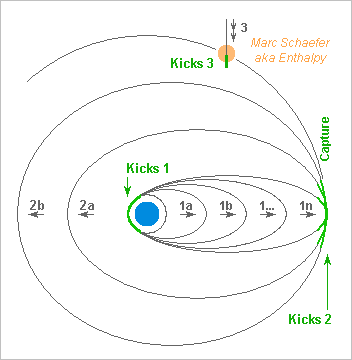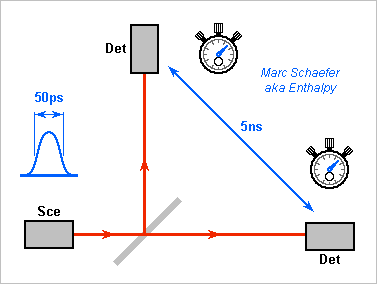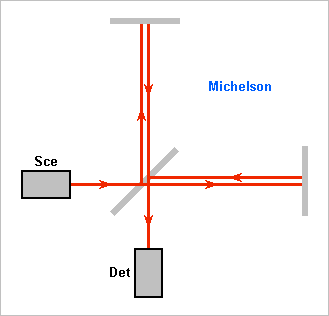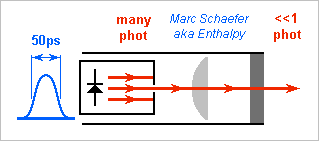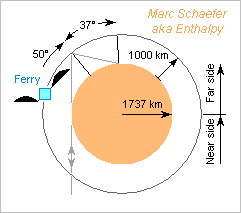-
Posts
3887 -
Joined
-
Last visited
-
Days Won
1
Content Type
Profiles
Forums
Events
Everything posted by Enthalpy
-
Rich people use a "network analyzer". Comfortable, overkill for one antenna. Find a radiocomm laboratory that has one, or buy a used one on eCreek for instance. Takes some time to learn for someone used to VHF and UHF. Amateur radio used a measurement bridge years ago, this must still exist. Once you have a generator, the bridge is dirt-cheap to tinker. You can also tinker a meter for reflected waves (a directional coupler). Needs a generator, and won't detail the real and imaginary part of the impedance, but the result gives directly the quality of the matching. All methods involve feeding the antenna with a signal, which get radiated, and this is not desired... - Do it in an anechoic chamber if you can - Or do it quickly with very little power in an isolated valley and don't be caught... - A noise source is better than a single frequency for that.
-
In a first approach: Mars weighs 6.4e23kg, Phobos 1.0e16kg Their distance is 9377km, so Phobos' gravitation dominates up to 16km from Phobos' centre only. So any orbit around Phobos needs R<16km BUT Phobos is 27*22*18km big, so there's very little room to fit. Then there are the less simple perturbations by Mars and also the Sun... ---------- First solution: land on Phobos instead of orbiting it. Take samples, preferably from several sites, do the same at Deimos, bring them back to Earth. Trivial with my Sunheat engine; described there http://www.scienceforums.net/topic/76627-solar-thermal-rocket/#entry755323 this was before the improved script http://www.scienceforums.net/topic/76627-solar-thermal-rocket/page-2#entry818683 so the mass back to Earth might be like 4.5t instead of 1.5t - almost too easy. Only sampling Mars is a challenge with the sunheat engine, coming later. ---------- Maybe an other possibility, but I'm not sure at all: use a Mars orbit instead, that is, >19km from Phobos. Phobos' attraction would deform it slightly to pass sometimes below, sometimes above, right, left... The orbit can be slightly tilted and elliptic to help. Tell me if you find one, it would serve at the small moons of Jupiter and Saturn, since the sunheat engine permits to orbit all their equatorial moons. At D~10km it's easier to land. ---------- One good possibility: stay at a Lagrangian point L1 or L2. They're 16km from Phobos, you make nice pictures from there. Very little fuel move the probe between them. http://en.wikipedia.org/wiki/Lagrangian_point
-

Drag Coefficient of Water in Relation to Air Question??
Enthalpy replied to dragforcequeen's topic in Classical Physics
Gliders (I am a glider pilot) don't use turbulators because they worsen the drag. A quick Internet search won't change that. By the way, the first link you give describes an airfoil profile from >50 years ago that doesn't resemble at all one of present day, the second link gives computed curves only, and the third link talks of turbulators on cylindrical rods, not on the wing. So we go back to the idea that on a well-designed shape, for instance a glider, the turbulators are bad. They help at cylinders and spheres, which one won't find on a good aeroplane. And then, they help to avoid stalling, but at the cost of increased drag. Most aeroplanes afford the more expensive leading-edge slats instead, to avoid this drag. You know, Ive been hearing about the shark skin for over 40 years. No use on gliders up to now. A few people try it again and again, imagine sometimes to observe something or often not (many more describe what they have read instead of experimenting), and nothing happens because the turbulators bring nothing good. If a corrugated adhesive tape at mid-chord did improve the drag, be 100% sure that all glider pilots worldwide would have adopted it within two years. But we continue to wash the wing and body carefully, to keep the mirror finish so carefully manufactured, because smooth is better. -
Remember the sampling of a lake below the Antarctic ice sheet about a year ago? They have found microbes living in the water, and the big way: 4,000 species observed in the small sample and 100,000 individuals per quarter teaspoon http://www.latimes.com/science/sciencenow/la-sci-sn-microbe-ecosystem-antartic-ice-sheet-20140819-story.html The microbes are said to feed on rock fine-ground by glacier movement, for which I'd like more details. Because, if they feed on still unoxidized metals, the same may happen on Europa (...see my script to put a probe there) and Enceladus, but if they chew organic matter produced earlier and elsewhere by an other life, the process doesn't suffice alone for life without sunlight. Very nice findings!
-
----- Earth to Moon ----- The ferry carries the prospectors to the Lunar orbit from a 400km low-Earth orbit, where one Atlas V 551, H-IIB or Ariane 5 has put the 18.8t. The ferry first (1) raises the apogee to the Moon's 384Mm. Fifteen 4.572m sunheat engines totalling 39N achieve the 3084m/s in approximately nine months, with pushes that must extend much around the perigee, hence exploit only 90% of the isp=1267s. This leaves 14268kg there. I've forgotten the eclipses. A polar Earth orbit improves that - or raise the perigee. Then (2) the ferry adds 532m/s to the apogee in about two pushes to be 300m/s slower than the Moon. It's at the North or South of the Moon. The ferry brakes 380m/s before periapsis and 11m/s after during the capture by the Moon, to reach a polar orbit with 2737km periapsis and 20260km apoapsis, according to the spreadsheet [MoonWeakBrake.xls in this folder] This leaves 13238kg. The ferry (3) brakes by 455m/s to circularize the orbit. Few months demand 90% efficient long pushes, leaving 12710kg on Lunar orbit, 1000km over the Moon's 1737km radius. We can begin to tinker seriously. This script can send other payloads to the Moon, for instance preset a lunar module in orbit for a manned mission, or a habitat on the Moon, or equipment that builds the habitat - pretty much everything that can wait. An Ariane V Me, a Heavy Falcon or Atlas, maybe an Atlas V 552, have more capacity. Marc Schaefer, aka Enthalpy
-

Drag Coefficient of Water in Relation to Air Question??
Enthalpy replied to dragforcequeen's topic in Classical Physics
The car's spoiler does improve the drag, yes - this is a for the golf ball a case where the stern has an unfavourable shape. On a glider, designers avoid that carefully. In addition, the spoiler reduces the noise and the rear uplift that would destabilize the car at high speed. The turbulators have a completely different function. Through turbulence, they introduce fast-moving air in the boundary layer, (books say "energize" the boundary layer without details) which retards stalling. Though, the effect on drag is bad, and this is why gliders have none and don't want any. Most planes rely mainly on the more complicated leading-edge slats rather than turbulators because of drag http://en.wikipedia.org/wiki/Leading-edge_slats Gliders are designed and produced as smooth as possible, and pilots wash all smashed mosquitos away before taking off, as they would increase the drag perceivably. Few years ago a new design emerged where elements protrude before the wing (non-swept wing, so that's not a chine). They're parallel to the flow at moderate angle of attack, hence introduce little drag, but make vortices as the angle of attack increases, bringing the same advantage. -
In post #20 I outlined that the instant collapse of the wavefunction isn't special to entangled particles and happens for a single particle as well. The experiment with one photon is easy (already done probably). ---------- Take a light source that produces short pulses, say 50ps long, and emits one photon during some pulses, most often none, so that pulses of several photons are scarce. Split in two beams sent apart, say over 1m each at 90°, so they are 5ns away from an other where detected. The photon is expected to be detected at either one end or the other, and after one propagation time within the pulse duration, so that no data can be transferred so quickly between the detector locations. Here as well, the wave function collapses instantly. ---------- The photon does take both paths: this is checked easily by modifying the experiment's downstream part into the usual Michelson interferometer - typically by removing the two fast detectors. http://en.wikipedia.org/wiki/Michelson_interferometer Fringes, reaction to the arms' length... reveal interferences resulting from two paths taken by the single photon. ---------- The source can use for instance a pulse-driven VCSEL: http://en.wikipedia.org/wiki/Vertical-cavity_surface-emitting_laser VIS offers the V40-850C1 (more references at other companies) for 100Gb/s Ethernet at 850nm in multimode fibres, with 10ps rise and fall time, and 30µm emitting diameter. 3mW light mean 600,000 photons per pulse. A 1µm pinhole improves the optical quality and leaves <700 photons per pulse. There, a first offset detector can serve as a time trigger. A lens makes a nice beam. An optical attenuator leaves <<1 photon per pulse, say mean 0.001 photon with <5 optical densities, so that only one pulse over 1000 contains several photons. A pulse repetition period of 20ns still emits 50,000 photons per second, of which 10,000 may be detected, or one million in 100s. The optical attenuator, or a set of, eases the adjustment of the setup with more light. Marc Schaefer, aka Enthalpy
-
The first message only shows wrong understanding of QM. Which, well, could be interpreted as a weakness of the theory for being too complicated or abstract, but we humans don't decide how Nature behaves, we only try to model it. In short: the two orbitals are not separated, they overlap; this is even mandatory for the transition to happen; the electron takes time to change its shape from one orbital to the other. It's called the fluorescence time and defines the transition bandwidth.
-

Drag Coefficient of Water in Relation to Air Question??
Enthalpy replied to dragforcequeen's topic in Classical Physics
I agree with the golf ball. I was thinking at shapes more adequate for aeroplanes and boats, where the stern would not be a hemisphere. The F16L experiment isn't relevant here. It sucks actively the boundary layer, a known technique that doesn't relate with the shark effect. Yes, many papers reported to observe an improvement with corrugated skins, but many others reported no improvement, over many decades. The net result is that air gliders still thrive to have a skin as smooth as possible, and so do airliners. You can trust gliders to adopt new ideas if they're better, even if unexplained or controversial: competition drives this activity, where neither designers nor pilots are conventional. -
It boils down to a matter of wording... In post #10 the thread opener tells "change of momentum, external force" and to this my example is an answer, with "the position does not oscillate". An exp(i*w*t) oscillating, I have nothing against.
-
Jpl's probe with ion propulsion has orbited one asteroid and head to an other one http://dawn.jpl.nasa.gov/mission/ The link here is to a thread where I describe how I imagine these missions are enabled by the sunheat engine, so none has been built up to now. Esa had conducted studies about this engine, but their design had difficulties (window, heat exchanger) which my design avoids. If you compare the figures (mass, duration...) of the missions I propose with the ones possible with chemical propulsion, it's a game changer. I'm sure companies or agencies will develop it; some questions here and elsewhere relate strongly with tecnologies I propose, so many people read my threads and invest some efforts in the development. Few answers: that's not a worry to me. I describe my ideas in forum threads so people can jump in if they want. For instance on a chemical forum, they just advised that some ideas I proposed were already common, showing me where to search - fine! These threads receive few replies but many visits, so I'm pleased that they raise interest. Atomic hydrogen is efficient. Spin wouldn't change much, except maybe for a hope to store it... but how? The sunheat engine I describe does dissociate a fraction of its hydrogen. That's why the chamber works at 30mbar instead of 1bar or 30bar. This partial dissociation raises the specific impulse from 800s to 1200s, and is obtained with a tungsten chamber.
-
1. "Ever possible", I try to avoid answering this. In a foreseeable future, the answer is no. 2. Shields against impacts? I don't worry about impacts, as they're so scarce. Probes flew through Saturn's rings and nothing happened. 3. Earth-like is a hype. We have a notion of their size, their distance to their star. No information about temperature, composition, atmosphere if any, presence of water, and so on. Land on them: too far away, not in any foreseeable future. 3b. We should first check Europa, Encelade and other moons in our Solar system. These are accessible to our space probes, in some future maybe to humans, and the conditions for (non-human) life may be not too bad there. 3c. Making Mars habitable for humans could be easier than going to an other star. 4. Andromeda? Other reasons? Who cares. We ignore completely what technology will be in such a future, nor if humans still exist, and they would have evolved so much and be so different from us that I feel no need to care. 5. In a spaceship? Still unknown. Radiations would kill them within few decades with present shields. 5b. Few humans would die of loneliness rather quickly. A group of two-sex animals needs >200 individuals to be genetically viable, in case you want to export the species. A single species does not make a viable biotope; we fully ignore how many are neeed. But then, why export the human species, especially if it gets extinct on Earth?
-

Can the quantum state of an electric current change its outcome?
Enthalpy replied to MirceaKitsune's topic in Quantum Theory
Because we observe brain activity through electric signals (EEG) many sources claim brain's activity to be an electric one, but it's chemistry, and electric signals are a by-product.. Chemistry is complicated, biochemistry more so...I expect most molecules and ions to have paired electrons, and even when not, the spin of a lone electron is probably not what influences the emission and capture of a neurotransmitter. But, well, we still discover unknown neurotransmitters presently. Giant magnetoresistance: http://en.wikipedia.org/wiki/Giant_magnetoresistance -

Drag Coefficient of Water in Relation to Air Question??
Enthalpy replied to dragforcequeen's topic in Classical Physics
Shark skin has been the topic of many wrong publications. Initial papers miscalculated the available propulsive force - by much more than 8% then - which may still be the case today. To my knowledge, attempts to reduce drag on man-made items by extra corrugations have consistently failed - and there have been many such attempts. The only success is not against drag but to favour lift, by hindering stalling. Air vs water: under a fuzzy limit of Mach 0.7, air is not compressible except for a proportionality correction between dP/P and dV/V, so that it behaves just like a liquid. The real difference is in the Reynolds number Re; if Re matches between the gas and the liquid, the analogy is accurate, and drag coefficients can be transposed accurately. The present situation is not to try stiff corrugated shapes, but skins (smooth or not) that dampen the movements to reduce the drag, possibly by retarding the turbulences. Ferroelectric Pvdf with an additional damping electric circuit has been tried; I have read no victory report up to now. -
No. At least the position does not oscillate, which is consistent with the original question, the lack of external force.
-
The setuop is globally complicated, possibly more than necessary, and the resulting answer as well. If the saline liquid conducts well enough and is grounded, the capacitance between the grey and black conductors is very small. It would take several MHz upwards for a saline solution to be mainly capacitive. This depends on the concentration and frequency. A semiconductor is a bizarre choice. Depending again on the dopant concentration, possibly the temperature, and the frequency, some semiconductors (like compensated GaAs) can be mainly capacitive, but if this one was deposited on the black metal (probable due to the shape) it's more likely resistive than capacitive. To reduce the capacitance, a metal would be better - or a good ceramic. And if you want to make a good coaxial cable, water does nothing good there, and grounding it is even worse. As it looks, you want a capacitance with materials not capacitive. What frequency, what resistivites...?
-
This thread looks like a way to waste our time.
-

Can the quantum state of an electric current change its outcome?
Enthalpy replied to MirceaKitsune's topic in Quantum Theory
The spin values can be prepared to be definite. This permits spintronic devices to show some effects right now; whether we get operating and useful chips some day is a matter of technology, not of theoretical limits. Every hard disk drive for several years uses a magnetic read sensor based exactly on electron spin in metals, through the giant magnetoresistive effect. At least this one is present technology. The spin in energy bands is perfectly understood and simple theory. It works exactly like anywhere else: two electrons per otherwise identical state. This was included in semiconductor theory right from the beginning, and is necessary to compute the filing of the bands. It's even necessary for atoms to stay together in a piece of metal. -
OK, I hope to understand the question better now. In empty space, hence without an external force, the electron's position doesn't oscillate. The electron just propagates smoothly, with its phase rotating. Take for instance a plane wave psi(x, y, z, t) = exp[i(w*t-k*x)] where w is the angular frequency related with the electron's energy, and k the wave vector. The distribution |psi|2 is uniform over time and space. It doesn't oscillate. The electron needs no external force for that. The electron does move, and has a momentum, because the locations of constant phase do. k*x just increases as much as w*t does, so the speed is w/k, exactly like any wave.
-

Can the quantum state of an electric current change its outcome?
Enthalpy replied to MirceaKitsune's topic in Quantum Theory
Spin still exists in metals and semiconductors. This enables spintronics, permits two electrons in otherwise the same state, and does influence the occupation statistics. -
The atom's nucleus provides this force. The electron oscillates when it is not an orbital (=a stationary bound wave), for instance when it's a combination of several orbitals of different energies. The energy difference defines the frequency of oscillation and of the radiated photon.
-
Here neither. Forget carbon nanotubes until someone observes decent properties in a full-scale composite. Think graphite composite meanwhile. A rod of graphite composite achieves about 1000m/s at the tip, whatever its length.
-
Sorry, YouTube consumes too much bandwidth. How is your structure? A truss with few beams, a simple shape? A few cases can be computed by hand, but often it's impossible or just too heavy, so people normally seek a software for that.
-
Hello, stone collectors and everyone! Moon rocks help understand our world, but all we have are meteoroids and 382kg of samples quickly collected from 6 small sites by the Apollo missions http://en.wikipedia.org/wiki/Moon_rock so a mission to bring back Moon samples from new sites would be exciting. I propose here a script to prospect many sites - including at Moon's far side :good: - taking the time needed to explore larger areas and pick the best samples. We don't need six Saturn-V for that goal because robots exist now and my sunheat rocket engine changes the game http://www.scienceforums.net/topic/76627-solar-thermal-rocket/ so one middleweight launch suffices. ---------- The mission comprises Several prospector robots that start from Lunar orbit, land, choose and collect samples over a long ground path, take-off to bring the samples to the Lunar orbit; And a ferry that transfers them from low-Earth orbit to Lunar orbit, and brings the samples from there to Earth. In addition, the ferry can have remote-sensing capabilities, like a sunlight-pumped laser and a hydrogen gun (if aiming properly). ----- Transmissions ----- I imagine robots that move autonomously to human-designated targets within an observed landscape, carry out simple sampling and analyses alone, but get help at sample choice and obstacles. The ferry relays the transmissions between Earth and Moon's far side - and its near side for pictures, limited video and heavy data at least. The ferry's 1000km high orbit overflies points 50° beyond our horizon while visible from Earth. The antipodal one-fourth of the far side is accessible to stored data transmission and often to real-time. While landing a prospector at nadir there, humans can't intervene - but the ferry's transmissions reach 37° farther than its nadir with 15° elevation, so real-time transmission with a landed prospector is often possible. Prospectors see the ferry with >15° elevation for >26 passes of >31min spaced by 3.6h spread over 4 days in daylight every 27 days. The ferry's orbital plane is essentialy fixed. I imagine it polar and, at the beginning, about aligned with Sun's direction. As the Moon rotates in 27 days around itself and Earth, prospectors of varied landing sites get active in sunlight, work and communicate. As Earth rotates around the Sun, the ferry's orbital plane changes from favourable noon-midnight to 6h-18h then improves again. Marc Schaefer, aka Enthalpy


